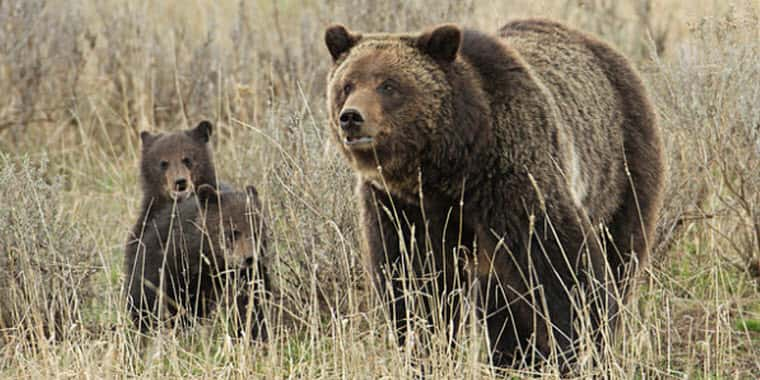Op-Ed by Nick Gevock, Conservation Director of the Montana Wildlife Federation
Montanans should be incredibly proud of bringing back one of our most cherished native wildlife species, the grizzly bear. They should also acknowledge that grizzlies are no longer “endangered.”
Four decades ago, grizzlies were struggling, especially in the ecosystem in and around Yellowstone National Park. The estimated population back then was a mere 136 bears. The bears were placed on the Endangered Species List in 1975 in an effort to save the species from blinking out. Today, after extensive work by public-land managers, ranchers, hunters, conservationists, campers and others, an estimated 700 bears live in the greater Yellowstone area.
This is a huge conservation success story, and it shows that the law works when it is fully implemented and fully funded. Now the Obama administration has proposed removing grizzlies from federal protection and returning management to state wildlife agencies. The proposal has drawn strong opinions from all sides, with much of the controversy focused on the emotional response to hunting grizzlies, something that might be permitted under state management. As a result, we are losing sight of the bigger and more important picture of grizzly bear conservation.
It’s necessary to remember that the purpose of the Endangered Species Act is to serve as a safety net for species that teeter on the brink of extinction. The law puts an emphasis on habitat, which is almost always the key factor in any species’ decline, and it includes strong regulatory language to ensure that a species can recover.
That said, the kind of recovery that warrants removal from the list is the ultimate goal of a listing. Once a species has recovered, it should be returned to state wildlife management, where it belongs.
It is true that such management might well include hunting, but conservationists need to look at the remarkable track record of species that are currently hunted: Nearly every species of wildlife that hunters value has thrived in our country, and with sound scientific management, grizzlies can do the same, and even grow in both numbers and range. It’s difficult for many non-hunters to understand, but it’s a solution that works in Alaska with brown bears and can work in the Lower 48 as well.
In fact, a study of four brown bear populations in Alaska — two populations in national parks that were not hunted and two adjoining populations that are — found that the hunted bears had larger litter sizes and better cub survival. There were other factors, including population density, but the study illustrated that bears can sustain and even thrive with regulated hunting. Research has consistently shown that brown bear management is dependent on protecting adult females, and the three states managing the Yellowstone grizzly population will do that through season dates that push harvest toward males, as well as total female sub quotas.
The successful recovery of the Yellowstone grizzly is evidenced by the fact that the population has been stable for many years. At the same time, grizzlies continue to expand farther out from the park. It’s a sign that the bears are re-inhabiting places where they were found historically. That’s essential, because the larger picture of grizzly bear conservation means making these bears not only tolerated in more areas, but welcomed. This is a challenge for many reasons. These larger habitat areas are home to livestock, communities, roads and other signs of civilization in both mountains and valleys.
Yet it’s important that we restore populations in these areas: If grizzly bears expand outward from Yellowstone, they could recolonize the Selway-Bitterroot ecosystem and also connect with relatives in the Northern Continental Divide. Both of these are crucial to long-term, region-wide species recovery.
While it won’t be easy to have bears in these places, it is possible. There are models of proactive conservation in Montana that have shown that we can get along with grizzlies.
One of the best examples is in the Blackfoot Valley. There, a coalition of diverse interests has instituted a strong carcass-removal and composting program to get dead livestock off the land so bears aren’t attracted to it. They’ve protected chicken coops, beehives and calving yards with electric fencing. And they’ve hired range riders to keep an eye on cattle.
The results have reduced grizzly depredations on livestock in that area by an impressive 93 percent. It’s a model that we can and should expand throughout Montana.
Mandating safe food storage on public lands and a robust public education campaign that includes managing the way garbage is handled will also help cut down on grizzly encounters. All of these measures require people to make changes. They require funding as well as cooperation. But for a valued native Montana species like the grizzly bear, it’s worth it. And when conservationists, landowners, wildlife managers and other stakeholders work together, success is highly likely.
Grizzly bears are big, powerful animals. They represent the ultimate symbol of the wild places that make Montana such a remarkable place. They also draw millions of tourists to our state every year. With careful management, cooperation and funding, we can restore grizzly bears across Montana and continue to build upon a great conservation success story.
The Montana Wildlife Federation (MWF) is Montana’s oldest, largest, and most effective conservation organization. MWF was founded in 1936 by hunters, anglers, landowners, and other conservationists who were concerned about the loss of Montana’s natural lands, healthy waters, and abundant wildlife.
Photo credits: Yellowstone National Park


